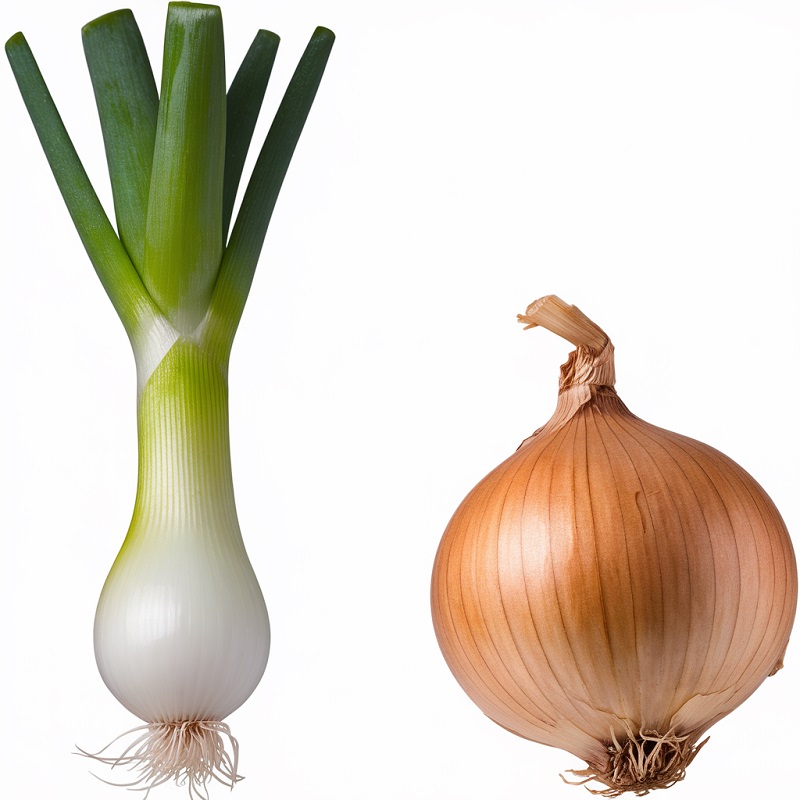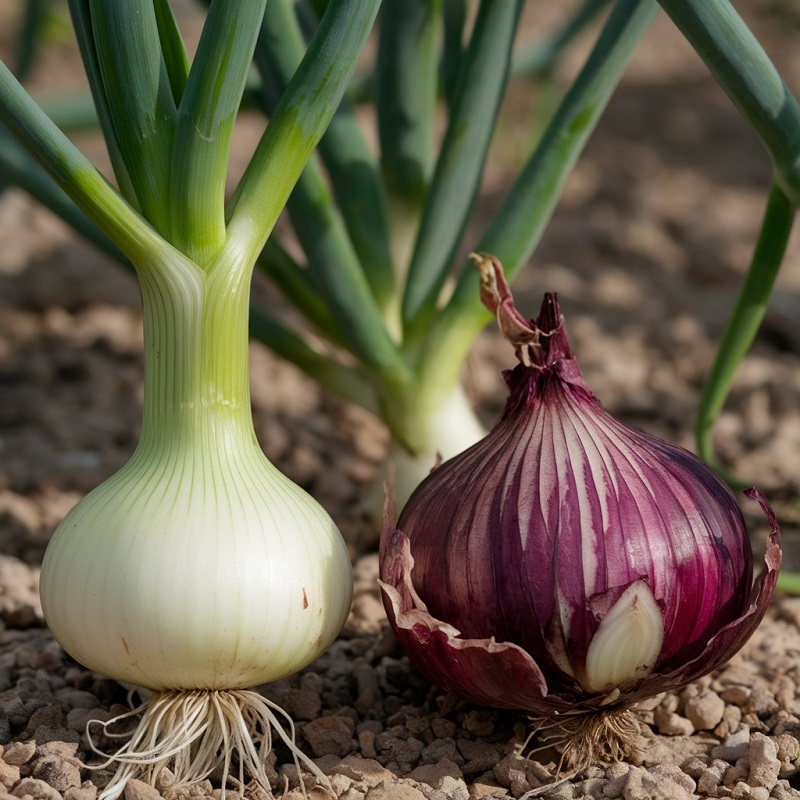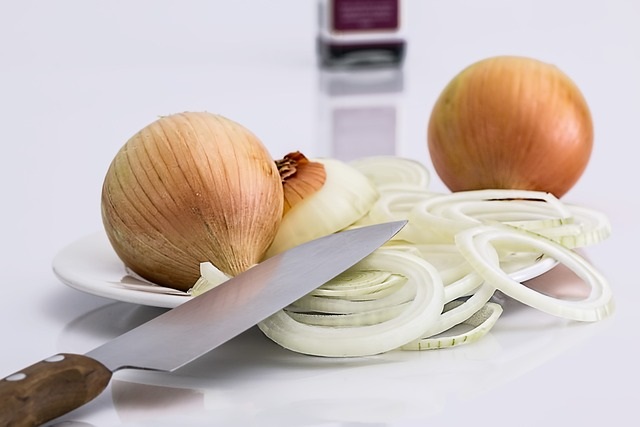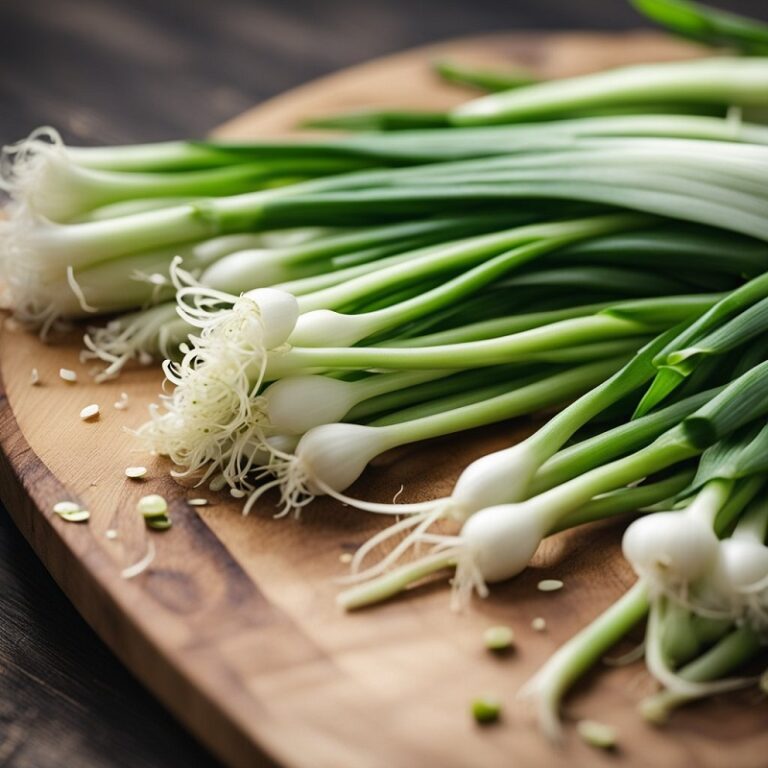Green onions and traditional onions are both members of the Allium family, which also includes garlic, leeks, and shallots. While they share some similarities, there are distinct differences between the two in terms of appearance, flavor, culinary uses, nutritional content, and cultivation. Understanding these differences can help you choose the right type of onion for your recipes and gardening needs.

Botanical Classification and Varieties
- Green Onions (Scallions):
- Scientific Name: Allium fistulosum or immature Allium cepa.
- Varieties: Include scallions and spring onions, though these terms are often used interchangeably.
- Appearance: Green onion has long, slender green stalks with a small, white bulb at the base. The entire plant is edible, both the green tops and the white part.
- Traditional Onions:
- Scientific Name: Allium cepa.
- Varieties: There are numerous varieties, including yellow onions, red onions, and white onions.
- Appearance: Traditional onions typically have a larger, more defined bulb with layers of papery skin. The green shoots (if present) are usually not consumed as part of the bulb.
Flavor Profile
- Green Onions:
- Taste: Mild, slightly sweet, and less pungent compared to traditional onions.
- Usage Impact: Their subtle flavor makes them ideal for raw applications like salads, garnishes, and fresh salsas where a strong onion flavor might overpower other ingredients.
- Traditional Onions:
- Taste: Varies by type but generally has a stronger, more pungent flavor. Yellow onions are known for their robust flavor, while red onions are slightly sweeter.
- Usage Impact: Their bold flavor holds up well in cooked dishes, such as soups, stews, sautés, and caramelized preparations where the flavor can develop and mellow.
Culinary Uses
- Green Onions:
- Common Uses: Fresh applications like topping for baked potatoes, tacos, and soups; ingredient in salads and cold dishes; used in stir-fries and as a garnish.
- Preparation: Typically used raw or added towards the end of cooking to preserve their delicate flavor and crisp texture.
- Traditional Onions:
- Common Uses: Base for a wide range of cooked dishes, including soups, stews, sauces, and sautés; used in grilling, roasting, and caramelizing.
- Preparation: Often cooked to enhance their sweetness and reduce pungency; can be diced, sliced, or chopped depending on the recipe.
Nutritional Content
Both green onions and traditional onions are nutritious, but their nutritional profiles differ slightly due to their growth stages and parts consumed.
- Green Onions:
- Nutrients: High in vitamins A, C, and K; contain antioxidants and fiber.
- Calories: Low in calories, making them a healthy addition to various dishes.
- Other Benefits: Rich in flavonoids, which have anti-inflammatory properties.
- Traditional Onions:
- Nutrients: Also high in vitamins C and B6; contain more carbohydrates and slightly higher calories due to the larger bulb.
- Calories: Slightly higher in calories compared to green onions but still low.
- Other Benefits: Contain sulfur compounds that have been linked to potential health benefits, including heart health and cancer prevention.
Cultivation and Growing Conditions
- Green Onions:
- Growing Time: Quick-growing, typically ready to harvest in 6-8 weeks.
- Soil Requirements: Prefer well-drained, fertile soil rich in organic matter.
- Sunlight: Require full sun, about 6 hours of direct sunlight daily.
- Watering: Need consistent moisture but should not be waterlogged.
- Propagation: Can be grown from seeds, transplants, or regrown from kitchen scraps by placing the white roots in water.
- Traditional Onions:
- Growing Time: Longer growing season, often requiring 90-120 days from planting to harvest.
- Soil Requirements: Also prefer well-drained, fertile soil but can tolerate a wider range of soil types.
- Sunlight: Full sun is essential for bulb development.
- Watering: Require regular watering, especially during bulb formation, but excessive moisture can lead to rot.
- Propagation: Typically grown from seeds, sets (small bulbs), or transplants.
Storage and Shelf Life
- Green Onions:
- Shelf Life: Shorter shelf life compared to traditional onions; best used fresh within one week.
- Storage Tips: Can be stored in the refrigerator, wrapped in a damp paper towel inside a plastic bag, or kept upright in a glass of water with the roots submerged.
- Traditional Onions:
- Shelf Life: Longer shelf life; can be stored for several weeks to months in a cool, dry, and well-ventilated place.
- Storage Tips: Keep in a mesh bag or basket to allow air circulation and prevent moisture buildup, which can cause sprouting or rotting.
Economic and Culinary Availability
- Green Onions:
- Availability: Widely available in grocery stores year-round, especially in the form of bunches.
- Cost: Generally inexpensive, but prices can vary based on season and region.
- Traditional Onions:
- Availability: Also widely available year-round, with different varieties available depending on the season.
- Cost: Typically low-cost staples in most households, with prices fluctuating based on type and seasonal availability.
Health Benefits
Both green onions and traditional onions offer various health benefits, but their specific advantages may differ.
- Green Onions:
- Antioxidants: High in antioxidants like quercetin, which can help reduce inflammation and combat oxidative stress.
- Bone Health: Rich in vitamin K, which is essential for bone health and blood clotting.
- Digestive Health: Contain fiber that aids in digestion and promotes a healthy gut microbiome.
- Traditional Onions:
- Heart Health: Sulfur compounds and flavonoids in traditional onions can help lower blood pressure and reduce cholesterol levels.
- Immune Support: High in vitamin C, which supports the immune system.
- Cancer Prevention: Some studies suggest that the compounds in traditional onions may help reduce the risk of certain cancers.
Cultural and Culinary Significance
- Green Onions:
- Global Cuisine: Used extensively in East Asian cuisines, such as Chinese, Korean, and Japanese dishes; also popular in Mexican, Mediterranean, and American cooking.
- Cultural Dishes: Essential in dishes like Korean kimchi, Japanese miso soup, Mexican pico de gallo, and American baked potato toppings.
- Traditional Onions:
- Global Cuisine: A fundamental ingredient in nearly every culinary tradition around the world, from French onion soup to Indian curries, Italian pasta sauces, and Middle Eastern stews.
- Cultural Dishes: Integral to dishes like French onion soup, Italian soffritto, Indian biryanis, and Middle Eastern falafel.
Environmental Impact and Sustainability
- Green Onions:
- Growing Footprint: Require less space and time to grow, making them suitable for urban gardening and small-scale farming.
- Sustainability: Can be regrown from scraps, reducing food waste and promoting sustainable kitchen practices.
- Traditional Onions:
- Growing Footprint: Larger plants require more space and resources, but onions are generally hardy and can be grown in a variety of climates.
- Sustainability: Onions have a long shelf life, reducing the frequency of purchases and potential packaging waste.
Final Words
While both green onions and traditional onions belong to the same family and share some overlapping uses, their differences in flavor, culinary applications, growth habits, and nutritional profiles make each suited to specific roles in the kitchen and garden. Green onions offer a milder, fresher taste ideal for raw dishes and quick garnishes, while traditional onions provide a robust flavor that enhances cooked dishes and forms the backbone of countless recipes worldwide. Understanding these distinctions allows you to make informed choices in both your cooking and gardening endeavors, ensuring that you get the best out of these versatile and essential alliums.






